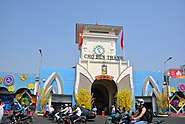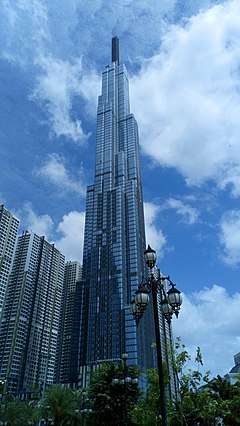Ho Chi Minh City
Ho Chi Minh City (Vietnamese: Thành phố Hồ Chí Minh; [tʰàjŋ̟ fǒ hò cǐ mīŋ̟] (![]()
Ho Chi Minh City Thành phố Hồ Chí Minh Saigon Sài Gòn | |
|---|---|
From top, left to right: Ho Chi Minh City skyline, Municipal Theatre, Nguyen Hue flower street around Tết holiday, Ho Chi Minh City Hall, Notre-Dame Cathedral Basilica of Saigon, Bến Thành Market, Independence Palace | |
| Nickname(s): Pearl of the Far East | |
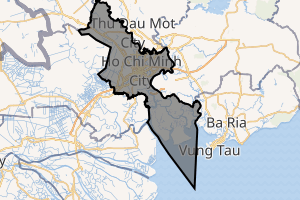
Interactive map outlining Ho Chi Minh City | |
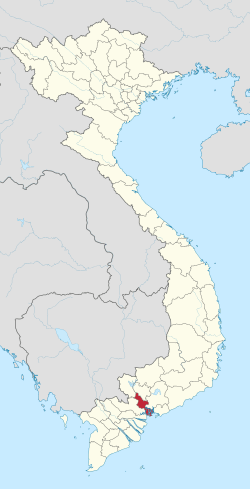 | |
 Ho Chi Minh City Location within Vietnam 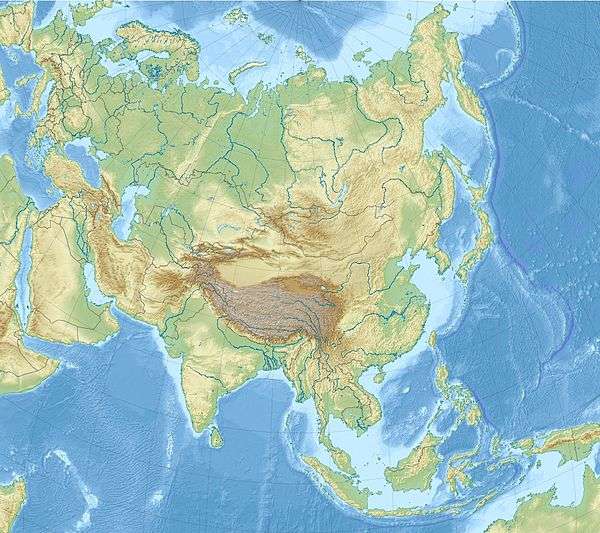 Ho Chi Minh City Location within Asia | |
| Coordinates: 10°48′N 106°39′E | |
| Country | |
| Region | Southeast |
| Settled | 1698 |
| Municipality status | 15 March 1874 2 July 1976 |
| Districts | 19 urban districts & 5 rural districts |
| Government | |
| • Type | Municipality |
| • Secretary of CPV | Nguyễn Thiện Nhân |
| • Chairman of People's Committee | Nguyễn Thành Phong |
| • Chairperson of People's Council | Nguyễn Thị Lệ |
| Area | |
| • Municipality | 2,061.2 km2 (795.83 sq mi) |
| • Metro | 10,619.4 km2 (4,100.17 sq mi) |
| Elevation | 19 m (63 ft) |
| Population (1/4/2019)[1] | |
| • Municipality | 8,993,082 |
| • Rank | 1st |
| • Density | 4,400/km2 (11,000/sq mi) |
| • Metro | 13,542,900 |
| • Metro density | 1,275/km2 (3,300/sq mi) |
| Demonym(s) | Saigonese |
| GDP (PPP) (2019)[3] | |
| • Total | US$236.1 billion |
| • Per capita | US$26,253 |
| GDP (nominal) (2019)[4] | |
| • Total | US$61.7 billion |
| • Per capita | US$6,862 |
| Time zone | UTC+07:00 (ICT) |
| Area codes | 28 |
| Website | www |
HCMC is the financial centre of Vietnam and is classified as a Beta+ World City by Globalization and World Cities Research Network.[7] It is home to the Ho Chi Minh City Stock Exchange, the largest stock exchange by total market capitalization in Vietnam and the headquarters of many national and international banks and companies.[8][9]
As a major gateway to Vietnam, the city received over 8.6 million international visitors in 2019, of which 4.1 million were overnight visitors.[10][11] The main passenger airport serving the metropolitan area is Tan Son Nhat International Airport, the busiest airport in Vietnam handling over 40 million passengers in 2019.[12][13]
Etymology
Ho Chi Minh City has gone by several different names during its history, reflecting settlement by different ethnic, cultural and political groups. Originally a trading port city of the Khmer Empire[14][15] known as Prey Nokor (Khmer: ព្រៃនគរ),[16][17][18][19] it is still known as Prey Nokor to Cambodians today.[17][18] In time, under the control of the Vietnamese, it was officially renamed Gia Dinh (嘉定), a name that was retained until the time of the French conquest in the 1860s, when it adopted the name Sài Gòn, westernized as Saïgon,[15] although the city was still indicated as 嘉定 on Vietnamese maps written in Chữ Hán until at least 1891.[20]
The current name, Ho Chi Minh City, was given after the Fall of Saigon in 1975 to honor Ho Chi Minh.[nb 1] Even today, however, the informal name of Sài Gòn remains in daily speech both domestically and internationally, especially among the Vietnamese diaspora. However, there is a technical difference between the two terms: Sài Gòn is commonly used to refer to the city center in District 1 and the adjacent areas, while Ho Chi Minh City refers more to the entire modern city with all its urban and rural districts.[15]
Saigon

An etymology of Saigon (or Sài Gòn in Vietnamese) is that Sài is a Sino-Vietnamese word (Hán tự: 柴) meaning "firewood, lops, twigs; palisade", while Gòn is another Sino-Vietnamese word (Hán tự: 棍) meaning "stick, pole, bole", and whose meaning evolved into "cotton" in Vietnamese (bông gòn, literally "cotton stick", i.e., "cotton plant", then shortened to gòn). This name may refer to the many kapok plants that the Khmer people had planted around Prey Nokor, and which can still be seen at Cây Mai temple and surrounding areas. It may also refer to the dense and tall forest that once existed around the city, a forest to which the Khmer name, Prey Nokor, already referred.[21]
Other proposed etymologies draw parallels from Tai-Ngon (堤 岸), the Cantonese name of Cholon, which means "embankment" (French: quais),[nb 2] and Vietnamese Sai Côn, a translation of the Khmer Prey Nokor (Khmer: ព្រៃនគរ). Prey means forest or jungle, and nokor is a Khmer word of Sanskrit origin meaning city or kingdom, and related to the English word 'Nation' – thus, "forest city" or "forest kingdom".[nb 3]
Truong Mealy (former director of King Norodom Sihanouk's royal Cabinet), says that, according to a Khmer Chronicle, The Collection of the Council of the Kingdom, Prey Nokor's proper name was Preah Reach Nokor (Khmer: ព្រះរាជនគរ), "Royal City"; later locally corrupted to "Prey kor", meaning "kapok forest", from which "Saigon" was derived ("kor" meaning "kapok" in Khmer and Cham, going into Vietnamese as "gòn").[22]
Ho Chi Minh City
The current official name, Thành phố Hồ Chí Minh, adopted in 1976 and abbreviated TP.HCM, is translated as Ho Chi Minh City, abbreviated HCMC, and in French as Hô-Chi-Minh-Ville (the circumflex is sometimes omitted), abbreviated HCMV. The name commemorates Ho Chi Minh, the first leader of North Vietnam. This name, though not his given name, was one he favored throughout his later years. It combines a common Vietnamese surname (Hồ, 胡) with a given name meaning "enlightened will" (from Sino-Vietnamese 志 明; Chí meaning 'will' or 'spirit', and Minh meaning 'light'), in essence, meaning "light bringer".[23]
History
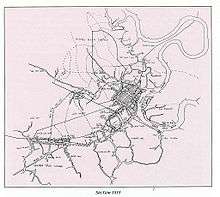
Khmer period
The earliest settlement in the area was a Funan temple at the location of the current Phụng Sơn Buddhist temple, founded in the 4th century AD.[19] A settlement called Baigaur was established on the site in the 11th century by the Champa.[19] When the Cham Empire was invaded by the Khmer people, Baigaur was renamed Prey Nokor,[19] which meant "Forest City". An alternative name was Preah Reach Nokor which, according to a Khmer Chronicle, meant "Royal City".[24] Prey Nokor grew on the site of a small fishing village and area of forest. This area is likely where modern Ho Chi Minh City now lies, and was inhabited by Khmer people for centuries before the arrival of the Vietnamese.
Beginning in the early 17th century, colonization of the area by Vietnamese settlers gradually isolated the Khmer of the Mekong Delta from their brethren in Cambodia proper and resulted in their becoming a minority in the delta. In 1623, King Chey Chettha II of Cambodia (1618–28) allowed Vietnamese refugees fleeing the Trịnh–Nguyễn civil war in Vietnam to settle in the area of Prey Nokor and to set up a customs house there.[25] Increasing waves of Vietnamese settlers, which the Cambodian kingdom could not impede because it was weakened by war with Thailand, slowly Vietnamized the area. In time, Prey Nokor became known as Saigon. Prey Nokor was the most important commercial seaport to the Khmers. The loss of the city and the rest of the Mekong Delta cut off Cambodia's access to the East Sea. Subsequently, the only remaining Khmers' sea access was south-westerly at the Gulf of Thailand e.g. at Kampong Saom and Kep.
Nguyễn Dynasty rule
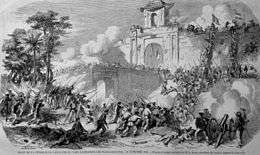
In 1698, Nguyễn Hữu Cảnh, a Vietnamese noble, was sent by the Nguyễn rulers of Huế by sea[26] to establish Vietnamese administrative structures in the area, thus detaching the area from Cambodia, which was not strong enough to intervene. He is often credited with the expansion of Saigon into a significant settlement. A large Vauban citadel called Gia Định was built[27] by Victor Olivier de Puymanel, one of the Nguyễn Ánh's French mercenaries. The citadel was later destroyed by the French following the Battle of Kỳ Hòa (see Citadel of Saigon). Initially called Gia Dinh, the Vietnamese city became Saigon in the 18th century.[19]
French colonial era
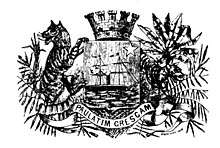
Colonized by France and Spain in 1859, and ceded to France by the 1862 Treaty of Saigon,[19] the city was influenced by the French during their colonisation of Vietnam, and a number of classical Western-style buildings and French villas in the city reflect this. Saigon had, in 1929, a population of 123,890, including 12,100 French.[28]
In 1931, a new région called Saïgon–Cholon consisting of Saïgon and Cholon was formed.[29] Saïgon and Cholon, meanwhile, remained separate cities with their respective mayors and municipal councils.[30] In 1956, after South Vietnam's independence from France in 1955, the région of Saïgon–Cholon became a single city called Saïgon following the merger of the two cities of Saïgon and Cholon.
Republic of Vietnam era
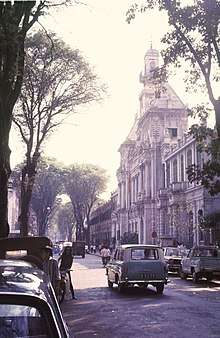
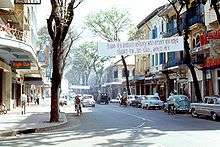

The Viet Minh proclaimed the independence of Vietnam in 1945 after a combined occupation by Vichy France and Japan, and before the Communist revolution in China. They were led by Ho Chi Minh. The Viet Minh-held sections of Vietnam were more concentrated in rural areas. Following the death of Franklin Roosevelt and the abandonment of anti-colonialist policies, the U.S. (in an attempt to control the spread of communism) supported France in regaining its control over the country, with effective control spanning mostly in the Southern half and parts of the Red River Delta region like Hanoi, Haiphong and Thái Bình.[31][32]
Former Emperor Bảo Đại made Saigon the capital of the State of Vietnam in 1949 with himself as head of state. In 1954, the Geneva Agreement partitioned Vietnam along the 17th parallel (Bến Hải River), with the communist Việt Minh, under Ho Chi Minh, gaining complete control of the northern half of the country, while the Saigon government continued to govern the State of Vietnam which continued in the southern half of the country and the southern half gaining independence from France. The State officially became the Republic of Vietnam when Bảo Đại was deposed by his Prime Minister Ngô Đình Diệm in the 1955 referendum. Saigon and Cholon, an adjacent city with mostly Sino-Vietnamese residents, were combined into an administrative unit known as the Đô Thành Sài Gòn (Capital City Saigon), or Thủ đô Sài Gòn (National Capital Saigon).
South Vietnam was a capitalist and anti-communist state which fought against the communist North Vietnamese and their Viet Cong proxy forces during the Vietnam War, with the assistance of the United States and other countries. The Viet Cong and North Vietnamese, on the other hand, were supported by the Soviet Union and the People’s Republic of China. During the 1968 Tet Offensive, communist forces launched a failed attempt to capture the city. On 30 April 1975, Saigon fell, ending the Vietnam War with a victory for North Vietnam.[33]
Post-Vietnam War and today
In the conclusion of the Vietnam War on 30 April 1975, the city came under the control of the Vietnamese People's Army. Among Vietnamese diaspora communities and particularly the U.S. (which had fought the communists), this event is commonly called the "Fall of Saigon", while the Socialist Republic of Vietnam refers to it as the "Liberation of Saigon". In 1976, upon the establishment of the unified communist Socialist Republic of Vietnam, the city of Saigon (including Cholon), the province of Gia Ðịnh and two suburban districts of two other nearby provinces were combined to create Ho Chi Minh City in honor of the late Communist leader Hồ Chí Minh. However, the former name Saigon is still widely used by the Vietnamese, especially in informal contexts.[34] Generally, the term Saigon refers only to the urban districts of Ho Chi Minh City.
Geography
Ho Chi Minh City is located in the south-eastern region of Vietnam, 1,760 km (1,090 mi) south of Hanoi. The average elevation is 19 metres (62 ft) above sea level. It borders Tây Ninh Province and Bình Dương Province to the north, Đồng Nai Province and Bà Rịa–Vũng Tàu Province to the east, Long An Province to the west and the East Sea to the south with a coast 15 km (9 mi) long. The city covers an area of 2,095 km2 (809 sq mi or 0.63% of the surface of Vietnam), extending up to Củ Chi District (12 mi or 19 km from the Cambodian border) and down to Cần Giờ on the Eastern Sea. The distance from the northernmost point (Phú Mỹ Hưng Commune, Củ Chi District) to the southernmost one (Long Hòa Commune, Cần Giờ District) is 102 km (63 mi), and from the easternmost point (Long Bình ward, District Nine) to the westernmost one (Bình Chánh Commune, Bình Chánh District) is 47 km (29 mi).
Climate
The city has a tropical climate, specifically a tropical savanna climate, with an average humidity of 78–82%.[35] The year is divided into two distinct seasons.[35] The rainy season, with an average rainfall of about 1,800 millimetres (71 in) annually (about 150 rainy days per year), usually lasts from May to November.[35] The dry season lasts from December to April.[35] The average temperature is 28 °C (82 °F), with little variation throughout the year.[35] The highest temperature recorded was 40.0 °C (104 °F) in April while the lowest temperature recorded was 13.8 °C (57 °F) in January.[35] On average, the city experiences between 2,400 and 2,700 hours of sunshine per year.[35]
| Climate data for Tan Son Nhat International Airport, Ho Chi Minh City | |||||||||||||
|---|---|---|---|---|---|---|---|---|---|---|---|---|---|
| Month | Jan | Feb | Mar | Apr | May | Jun | Jul | Aug | Sep | Oct | Nov | Dec | Year |
| Record high °C (°F) | 36.4 (97.5) |
38.7 (101.7) |
39.4 (102.9) |
40.0 (104.0) |
39.0 (102.2) |
37.5 (99.5) |
35.2 (95.4) |
35.0 (95.0) |
35.3 (95.5) |
34.9 (94.8) |
35.0 (95.0) |
36.3 (97.3) |
40.0 (104.0) |
| Average high °C (°F) | 31.6 (88.9) |
32.9 (91.2) |
33.9 (93.0) |
34.6 (94.3) |
34.0 (93.2) |
32.4 (90.3) |
32.0 (89.6) |
31.8 (89.2) |
31.3 (88.3) |
31.2 (88.2) |
31.0 (87.8) |
30.8 (87.4) |
32.3 (90.1) |
| Daily mean °C (°F) | 26.0 (78.8) |
26.8 (80.2) |
28.0 (82.4) |
29.2 (84.6) |
28.8 (83.8) |
27.8 (82.0) |
27.5 (81.5) |
27.4 (81.3) |
27.2 (81.0) |
27.0 (80.6) |
26.7 (80.1) |
26.0 (78.8) |
27.4 (81.3) |
| Average low °C (°F) | 21.1 (70.0) |
22.5 (72.5) |
24.4 (75.9) |
25.8 (78.4) |
25.2 (77.4) |
24.6 (76.3) |
24.3 (75.7) |
24.3 (75.7) |
24.4 (75.9) |
23.9 (75.0) |
22.8 (73.0) |
21.4 (70.5) |
23.7 (74.7) |
| Record low °C (°F) | 13.8 (56.8) |
16.0 (60.8) |
17.4 (63.3) |
20.0 (68.0) |
20.0 (68.0) |
19.0 (66.2) |
16.2 (61.2) |
20.0 (68.0) |
16.3 (61.3) |
16.5 (61.7) |
15.9 (60.6) |
13.9 (57.0) |
13.8 (56.8) |
| Average rainfall mm (inches) | 13.8 (0.54) |
4.1 (0.16) |
10.5 (0.41) |
50.4 (1.98) |
218.4 (8.60) |
311.7 (12.27) |
293.7 (11.56) |
269.8 (10.62) |
327.1 (12.88) |
266.7 (10.50) |
116.5 (4.59) |
48.3 (1.90) |
1,931 (76.01) |
| Average rainy days | 2.4 | 1.0 | 1.9 | 5.4 | 17.8 | 19.0 | 22.9 | 22.4 | 23.1 | 20.9 | 12.1 | 6.7 | 155.6 |
| Average relative humidity (%) | 72 | 70 | 70 | 72 | 79 | 82 | 83 | 83 | 85 | 84 | 80 | 77 | 78 |
| Mean monthly sunshine hours | 245 | 246 | 272 | 239 | 195 | 171 | 180 | 172 | 162 | 182 | 200 | 226 | 2,490 |
| Source 1: Vietnam Institute for Building Science and Technology,[36] Asian Development Bank[35] | |||||||||||||
| Source 2: World Meteorological Organization (rainfall)[37] | |||||||||||||
Flooding
Ho Chi Minh City is considered one of the cities most vulnerable to the effects of climate change, in particular flooding. During the rainy season, a combination of high tide, heavy rains, high flow volume in the Saigon River and Dong Nai River and land subsidence results in regular flooding in several parts of the city.[38][39] A once-in-100 year flood would cause 23% of the city to flood.[40]
Administration
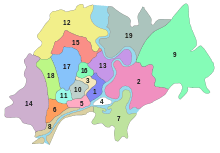
1–12. Districts 1 to 12
13. Bình Thạnh
14. Bình Tân
15. Gò Vấp
16. Phú Nhuận
17. Tân Bình
18. Tân Phú
19. Thủ Đức
Ho Chi Minh City is a municipality at the same level as Vietnam's provinces, which is subdivided into 24 district-level sub-divisions (as of 2003):
- 5 rural districts (1,601 km2 or 618 sq mi in area), which are designated as rural (huyện):
- 19 urban districts (494 km2 or 191 sq mi in area), which are designated urban or suburban (quận):
They are further subdivided into 5 commune-level towns (or townlets), 58 communes, and 259 wards (as of 2006, see List of HCMC administrative units below).[41]
City government
The Ho Chi Minh City People's Committee is a 13-member executive branch of the city. The current chairman is Nguyễn Thành Phong. There are several vice chairmen and chairwomen on the committee with responsibility over various city departments. The legislative branch of the city is the Ho Chi Minh City People's Council and consists of 95 members. The current Chairwoman is Nguyễn Thị Quyết Tâm. The judiciary branch of the city is the Ho Chi Minh City People's Court. The current Judge is Ung Thị Xuân Hương. The executive committee of Communist Party of Ho Chi Minh City is the leading organ of the Communist Party in Ho Chi Minh City. The current secretary is Nguyễn Thiện Nhân. The chairman of the People's Committee is ranked second in the city politics after the Secretary of the Communist Party, while the chairman of the People's Council is ranked third.
List of HCMC administrative units | ||||||||
|---|---|---|---|---|---|---|---|---|
| Name of district Dec. 2003 |
Sub-division units Dec. 2003 |
Area (km2) Dec. 2008 |
Population as of census 1 October 2004 |
Population as of census 1 April 2009 |
Population 2010[42] |
Population 2011[43] |
Population 2015[44] |
Population/km2 2011 |
| Urban districts | ||||||||
| District 1 | 10 wards | 7.73 | 198,032 | 180,225 | 187,435 | 185,715 | 193,632 | 24,025 |
| District 2 | 11 wards | 49.74 | 125,136 | 147,490 | 140,621 | 136,497 | 147.168 | 2,744 |
| District 3 | 14 wards | 4.92 | 201,122 | 190,553 | 188,945 | 188,898 | 196,333 | 38,393 |
| District 4 | 15 wards | 4.18 | 180,548 | 180,980 | 183,261 | 183,043 | 186,727 | 43,790 |
| District 5 | 15 wards | 4.27 | 170,367 | 171,452 | 174,154 | 175,217 | 178,615 | 41,034 |
| District 6 | 14 wards | 7.19 | 241,379 | 249,329 | 253,474 | 251,902 | 258,945 | 35,035 |
| District 7 | 10 wards | 35.69 | 159,490 | 244,276 | 274,828 | 265,997 | 310,178 | 7,453 |
| District 8 | 16 wards | 19.18 | 360,722 | 408,772 | 418,961 | 421,547 | 431,969 | 21,978 |
| District 9 | 13 wards | 114 | 202,948 | 256,257 | 263,486 | 269,068 | 290,620 | 2,360 |
| District 10 | 15 wards | 5.72 | 235,231 | 230,345 | 232,450 | 234,188 | 238,558 | 40,942 |
| District 11 | 16 wards | 5.14 | 224,785 | 226,854 | 232,536 | 234,293 | 230,596 | 45,582 |
| District 12 | 11 wards | 52.78 | 290.129 | 405,360 | 427,083 | 451,737 | 510,326 | 8,589 |
| Gò Vấp District | 16 wards | 19.74 | 452,083 | 522,690 | 548,145 | 561,068 | 634,146 | 28,423 |
| Tân Bình District | 15 wards | 22.38 | 397,569 | 421,724 | 430,436 | 430,350 | 459,029 | 19,229 |
| Tân Phú District | 11 wards | 16.06 | 366,399 | 398,102 | 407,924 | 419,227 | 464,493 | 26,103 |
| Bình Thạnh District | 20 wards | 20.76 | 423,896 | 457,362 | 470,054 | 479,733 | 487,985 | 23,109 |
| Phú Nhuận District | 15 wards | 4.88 | 175,293 | 174,535 | 175,175 | 175,631 | 182,477 | 35,990 |
| Thủ Đức District | 12 wards | 49.76 | 336,571 | 442,177 | 455,899 | 474,547 | 528,413 | 9,537 |
| Bình Tân District | 10 wards | 51.89 | 398,712 | 572,132 | 595,335 | 611,170 | 686,474 | 11,778 |
| Total urban districts | 259 wards | 496.04 | 5,140,412 | 5,880,615 | 6,060,202 | 6,149,817 | 6.508.647 | 12,398 |
| Districts | ||||||||
| Củ Chi District | 20 communes, 1 township | 434.5 | 288,279 | 343,155 | 355,822 | 362,454 | 403,038 | 834 |
| Hóc Môn District | 11 communes, 1 township | 109.18 | 245,381 | 349,065 | 358,640 | 363,171 | 422,471 | 3326 |
| Bình Chánh District | 15 communes, 1 township | 252.69 | 304,168 | 420,109 | 447,291 | 465,248 | 591,451 | 1841 |
| Nhà Bè District | 6 communes, 1 township | 100.41 | 72,740 | 101,074 | 103,793 | 109,949 | 139,225 | 1095 |
| Cần Giờ District | 6 communes, 1 township | 704.22 | 66,272 | 68,846 | 70,697 | 70,499 | 74,960 | 100 |
| Total (suburban) districts | 58 communes, 5 townships | 1,601 | 976,839 | 1,282,249 | 1,336,244 | 1,371,321 | 1.631.145 | 857 |
| Whole city | 259 wards, 58 communes, 5 townships | 2,097.06 | 6,117,251 | 7,162,864 | 7,396,446 | 7,521,138 | 8.072.129 | 3,587 |
Demographics
| Historical population | ||||||||
|---|---|---|---|---|---|---|---|---|
| Year | Area km2 | Population | Person/km2 | Urban | Rural | |||
| Census[45] | ||||||||
| 1999 | - | 5,034,058 | - | 4,207,825 | 826,233 | |||
| 2004 | - | 6,117,251 | - | 5,140,412 | 976,839 | |||
| 2009 | 2,097.1 | 7,162,864 | 3,416 | 5,880,615 | 1,282,249 | |||
| 2019 | 2,061.2 | 8,993,082 | 4,363 | 7,127,364 | 1,865,718 | |||
| Estimate | ||||||||
| 2010 | 2,095.6 | 7,346,600 | 3,506 | 6,114,300 | 1,232,300 | |||
| 2011 | 2,095.6 | 7,498,400 | 3,578 | 6,238,000 | 1,260,400 | |||
| 2012 | 2,095.6 | 7,660,300 | 3,655 | 6,309,100 | 1,351,100 | |||
| 2013 | 2,095.6 | 7,820,000 | 3,732 | 6,479,200 | 1,340,800 | |||
| 2014 | 2,095.5 | 7,981,900 | 3,809 | 6,554,700 | 1,427,200 | |||
| 2015 | 2,095.5 | 8,127,900 | 3,879 | 6,632,800 | 1,495,100 | |||
| 2016 | 2,061.4 | 8,287,000 | 4,020 | 6,733,100 | 1,553,900 | |||
| 2017 | 2,061.2 | 8,444,600 | 4,097 | 6,825,300 | 1,619,300 | |||
| Sources:[46][47][48][49] | ||||||||
The population of Ho Chi Minh City, as of the 1 October 2004 census, was 6,117,251 (of which 19 inner districts had 5,140,412 residents and 5 suburban districts had 976,839 inhabitants).[41] In mid-2007, the city's population was 6,650,942 – with the 19 inner districts home to 5,564,975 residents and the five suburban districts containing 1,085,967 inhabitants. The result of the 2009 Census shows that the city's population was 7,162,864 people,[50] about 8.34% of the total population of Vietnam, making it the highest population-concentrated city in the country. As of the end of 2012, the total population of the city was 7,750,900 people, an increase of 3.1% from 2011.[51] As an administrative unit, its population is also the largest at the provincial level.
The city's population is expected to grow to 13.9 million by 2025.[52] The population of the city is expanding faster than earlier predictions. In August 2017 the city's mayor, Nguyen Thanh Phong, admitted that previous estimates of 8–10 million were drastic underestimations.[53] The actual population (including those who have not officially registered) was estimated 13 million in 2017.[54] The Ho Chi Minh City Metropolitan Area, a metropolitan area covering most parts of the southeast region plus Tiền Giang Province and Long An Province under planning, will have an area of 30,000 square kilometres (12,000 sq mi) with a population of 20 million inhabitants by 2020.[55] Inhabitants of Ho Chi Minh City are usually known as "Saigonese" in English and "dân Sài Gòn" in Vietnamese.
Ethnic groups
The majority of the population are ethnic Vietnamese (Kinh) at about 93.52%. Ho Chi Minh City's largest minority ethnic group are the Chinese (Hoa) with 5.78%. Cholon – in District 5 and parts of Districts 6, 10 and 11 – is home to the largest Chinese community in Vietnam. The Hoa (Chinese) speak a number of varieties of Chinese, including Cantonese, Teochew (Chaozhou), Hokkien, Hainanese and Hakka; smaller numbers also speak Mandarin Chinese. Other ethnic minorities include Khmer with 0.34%, and Cham with 0.1%.[56]
Religion
The three most prevalent religions in Ho Chi Minh City are Mahayana Buddhism with Taoism and Confucianism (via ancestor worship), which are often celebrated together in the same temple. Most Vietnamese and Han Chinese are strongly influenced by these traditional religious practices. There is a sizeable community of Roman Catholics, representing about 10% of the city's population.[57] Other minority groups include Hòa Hảo, Cao Đài, Protestants, Muslims, Hindus, and members of the Bahá'í Faith.
Economy
Ho Chi Minh City is the economic center of Vietnam and accounts for a large proportion of the economy of Vietnam. Although the city takes up just 0.6% of the country's land area, it contains 8.34% of the population of Vietnam, 20.2% of its GDP, 27.9% of industrial output and 34.9% of the FDI projects in the country in 2005.[58] In 2005, the city had 4,344,000 labourers, of whom 130,000 are over the labour age norm (in Vietnam, 60 for male and 55 for female workers).[59] In 2009, GDP per capita reached $2,800, compared to the country's average level of $1,042.[60]
2006
As of June 2006, the city has been home to three export processing zones and twelve industrial parks. Ho Chi Minh City is the leading recipient of foreign direct investment in Vietnam, with 2,530 FDI projects worth $16.6 billion at the end of 2007.[61] In 2007, the city received over 400 FDI projects worth $3 billion.[62]
2007
In 2007, the city's GDP was estimated at $14.3 billion, or about $2,180 per capita, up 12.6 percent from 2006 and accounting for 20% of the country's GDP. The GDP adjusted to Purchasing Power Parity (PPP) reached $71.5 billion, or about $10,870 per capita (approximately three times higher than the country's average). The city's Industrial Product Value was $6.4 billion, equivalent to 30% of the value of the entire nation. Export – Import Turnover through HCMC ports accounted for $36 billion, or 40% of the national total, of which export revenue reached $18.3 billion (40% of Vietnam's total export revenues). In 2007, Ho Chi Minh City's contribution to the annual revenues in the national budget increased by 30 percent, accounting for about 20.5 percent of total revenues. The consumption demand of Ho Chi Minh City is higher than other Vietnamese provinces and municipalities and 1.5 times higher than that of Hanoi.[63]
2008
In 2008, it attracted $8.5 billion in FDI.[64] In 2010, the city's GDP was estimated at $20.902 billion, or about $2,800 per capita, up 11.8 percent from 2009.[65]
2012
By the end of 2012, the city's GDP was estimated around $28,595 billion , or about $3,700 per capita, up 9.2 percent from 2011.[66] Total trade (export and import) reached $47.7 billion, with export at $21.57 billion and import $26.14 billion.[51]
2013
In 2013, GDP of the city grew 7.6% by Q1, 8.1% by Q2, and 10.3% by the end of Q3. By the end of 2013, the city's GDP grew 9.3%, with GDP per capita reaching $4,500.[67]
2014
By the end of 2014, the city's GDP grew 9.5%, with GDP per capita reaching $5,100.[68]
Sectors
The economy of Ho Chi Minh City consists of industries ranging from mining, seafood processing, agriculture, and construction, to tourism, finance, industry and trade. The state-owned sector makes up 33.3% of the economy, the private sector 4.6%, and the remainder in foreign investment. Concerning its economic structure, the service sector accounts for 51.1%, industry and construction account for 47.7% and forestry, agriculture and others make up just 1.2%.[69]
Quang Trung Software Park is a software park situated in District 12. The park is approximately 15 km (9 mi) from downtown Ho Chi Minh City and hosts software enterprises as well as dot.com companies. The park also includes a software training school. Dot.com investors here are supplied with other facilities and services such as residences and high-speed access to the internet as well as favourable taxation. Together with the Hi-Tech Park in District 9, and the 32 ha. software park inside Tan Thuan Export Processing Zone in District 7 of the city, Ho Chi Minh City aims to become an important hi-tech city in the country and the South-East Asia region.
This park helps the city in particular and Vietnam in general to become an outsourcing location for other enterprises in developed countries, as India has done. Some 300,000 businesses, including many large enterprises, are involved in high-tech, electronic, processing and light industries, and also in construction, building materials and agricultural products. Additionally, crude oil is a popular economic base in the city. Investors are still pouring money into the city. Total local private investment was 160 billion đồng (US$7.5 million)[70] with 18,500 newly founded companies. Investment trends to high technology, services and real estate projects.
As of June 2006, the city had three export processing zones and twelve industrial parks, in addition to Quang Trung Software Park and Ho Chi Minh City hi-tech park. Intel has invested about 1 billion dollars in a factory in the city. More than fifty banks with hundreds of branches and about 20 insurance companies are also located inside the city. The Stock Exchange, the first stock exchange in Vietnam, was opened in 2001. There are 171 medium and large-scale markets as well as several supermarket chains, shopping malls, and fashion and beauty centres.
Some of the larger shopping malls and plazas opened recently include:
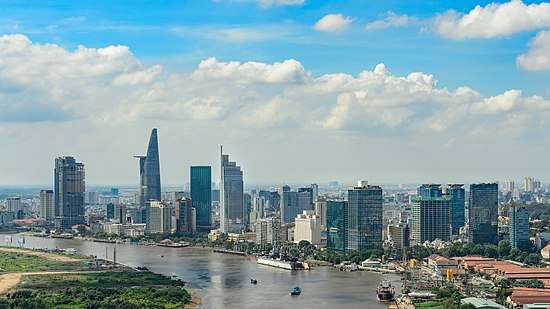
- Maximark – Multiple locations (District 10, and Tan Binh District)
- Satramart – 460 3/2 Street, Ward 12, District 10
- Auchan (2016) – Multiple locations (District 10, and Go Vap District)
- Lotte Mart – Multiple locations (District 7, District 11, and Tan Binh District)
- AEON Mall Tan Phu Celadon (2014) – Multiple locations (Binh Tan District, and Tan Phu District)
- SC VivoCity (2015) – 1058 Nguyen Van Linh Boulevard, Tan Phong Ward, District 7
- Zen Plaza (1995) – 54–56 Nguyễn Trãi St, District 1
- Saigon Centre (1997) – 65 Lê Lợi Blvd, Ben Nghe Ward, District 1
- Diamond Plaza (1999) – 34 Le Duan Blvd, District 1
- Big C (2002) – Multiple locations (District 10, Binh Tan District, Go Vap District, Phu Nhuan District, and Tan Phu District)
- METRO Cash & Carry/Mega Market – Multiple locations (District 2, District 6, and District 12)
- Crescent Mall – Phu My Hung, District 7
- Parkson (2005–2009) – Multiple locations (District 1, District 2, District 5, District 7, District 11, and Tan Binh District)
- Saigon Paragon (2009) – 3 Nguyễn Lương Bằng St, Tan Phu Ward, District 7
- NowZone (2009) – 235 Nguyen Van Cu Ave, Nguyen Cu Trinh Ward, District 1
- Kumho Asiana Plaza (2010) – 39 Le Duan Blvd, Ben Nghe Ward, District 1
- Vincom Centre (2010) – 70–72 Lê Thánh Tôn St, Ben Nghe Ward, District 1
- Union Square – 171 Lê Thánh Tôn st, Ben Nghe Ward, District 1
- Vincom Mega Mall (2016) – Số 161 Xa Lộ Hà Nội, P. Thảo Điền, District. 2
- Bitexco Financial Tower (2010) Hẻm số 2 Hàm Nghi Blvd, Ben Nghe Ward, District 1
- Co.opmart – Multiple locations (District 1, District 3, District 5, District 6, District 7, District 8, District 10, District 11, District 12, Binh Chanh District, Binh Tan District, Binh Thanh District, Cu Chi District, Go Vap District, Hoc Mon District, Phu Nhuan District, Tan Phu District, and Thu Duc District)
- Landmark 81 (2018) – 208 Nguyễn Hữu Cảnh, Binh Thanh District
In 2007, three million foreign tourists, about 70% of the total number of tourists to Vietnam, visited the city. Total cargo transport to Ho Chi Minh City's ports reached 50.5 million metric tonnes,[71] nearly one-third of the total for Vietnam.
New urban areas
With a population now of 8,382,287 (as of Census 2010 on 1 April 2010)[72] (registered residents plus migrant workers as well as a metropolitan population of 10 million), Ho Chi Minh City needs increased public infrastructure.[41] To this end, the city and central governments have embarked on an effort to develop new urban centres. The two most prominent projects are the Thu Thiem city centre in District 2 and the Phu My Hung Urban Area, a new city centre in District 7 (as part of the Saigon South project) where various international schools such as Saigon South International School and Australia's Royal Melbourne Institute of Technology are located. In December 2007, Phu My Hung's new City Centre completed the 17.8 km 10–14 lane wide Nguyen Van Linh Boulevard linking the Saigon port areas, Tan Thuan Export Processing Zone to the National Highway 1 and the Mekong Delta area. In November 2008, a brand new trade centre, Saigon Exhibition and Convention Centre, also opened its doors. Other projects include Grandview, Waterfront, Sky Garden, Riverside and Phu Gia 99. Phu My Hung's new City Center received the first Model New City Award from the Vietnamese Ministry of Construction.
Tourism
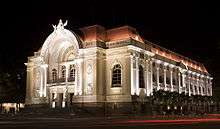
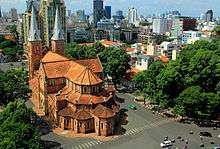
Tourist attractions in Ho Chi Minh City are mainly related to periods of French colonization and the Vietnam War. The city's center has some wide American-style boulevards and a few French colonial buildings. The majority of these tourist spots are located in District 1 and are a short distance from each other. The most prominent structures in the city centre are the Reunification Palace (Dinh Thống Nhất), City Hall (Ủy ban nhân dân Thành phố), Municipal Theatre (Nhà hát thành phố, also known as the Opera House), City Post Office (Bưu điện thành phố), State Bank Office (Ngân hàng nhà nước), City People's Court (Tòa án nhân dân thành phố) and Notre-Dame Cathedral (Nhà thờ Đức Bà) the cathedral was constructed between 1863 and 1880. Some of the historic hotels are the Hotel Majestic, dating from the French colonial era, and the Rex and Caravelle hotels are former hangouts for American officers and war correspondents in the 1960s & '70s.[73]
The city has various museums including the Ho Chi Minh City Museum, Museum of Vietnamese History, the Revolutionary Museum, the Museum of south-eastern Armed Forces, the War Remnants Museum, the Museum of Southern Women, the Museum of Fine Arts, the Nha Rong Memorial House, and the Ben Duoc Relic of Underground Tunnels. The Củ Chi tunnels are north-west of the city in Củ Chi District. The Saigon Zoo and Botanical Gardens, in District 1, dates from 1865. The Đầm Sen Tourist and Cultural Park, Suối Tiên Amusement and Culture Park, and Cần Giờ's Eco beach resort are three recreational sites inside the city which are popular with tourists. Aside from the Municipal Theatre, there are other places of entertainment such as the Bến Thành theatre, Hòa Bình theatre, and the Lan Anh Music Stage. Ho Chi Minh City is home to hundreds of cinemas and theatres, with cinema and drama theatre revenue accounting for 60–70% of Vietnam's total revenue in this industry. Unlike other theatrical organisations found in Vietnam's provinces and municipalities, residents of Ho Chi Minh City keep their theatres active without the support of subsidies from the Vietnamese government. The city is also home to most of the private film companies in Vietnam.
Like many of Vietnam's smaller cities, the city boasts a multitude of restaurants serving typical Vietnamese dishes such as phở or rice vermicelli. Backpacking travellers most often frequent the "Backpackers’ Quarter" on Phạm Ngũ Lão Street and Bùi Viện Street, District 1.[74]
It was approximated that 4.3 million tourists visited Vietnam in 2007, of which 70 percent, approximately 3 million tourists, visited Ho Chi Minh City.[75] According to the most recent international tourist statistic, Ho Chi Minh City welcomed 6 million tourists in 2017.[76]
According to Mastercard's 2019 report, Ho Chi Minh City is also the country's second most visited city (18th in Asia Pacific), with 4.1 million overnight international visitors in 2018 (after Hanoi with 4.8 million visitors).[10]
Transport
Air
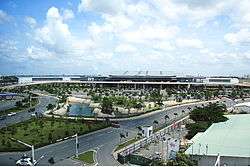
The city is served by Tân Sơn Nhất International Airport, the largest airport in Vietnam in terms of passengers handled (with an estimated number of over 15.5 million passengers per year in 2010, accounting for more than half of Vietnam's air passenger traffic[77][78]). Long Thành International Airport is scheduled to begin operating in 2025. Based in Long Thành District, Đồng Nai Province, about 40 km (25 mi) east of Ho Chi Minh City, Long Thành Airport will serve international flights, with a maximum traffic capacity of 100 million passengers per year when fully completed; Tân Sơn Nhất Airport will serve domestic flights.[79]
Rail
Ho Chi Minh City is also a terminal for many Vietnam Railways train routes in the country. The Reunification Express (tàu Thống Nhất) runs from Ho Chi Minh City to Hanoi from Saigon Railway Station in District 3, with stops at cities and provinces along the line.[80] Within the city, the two main stations are Sóng Thần and Sài Gòn. In addition, there are several smaller stations such as Dĩ An, Thủ Đức, Bình Triệu, Gò Vấp. However, rail transport is not fully developed and presently comprises only 0.6% of passenger traffic and 6% of goods shipments.[81]
Water
The city's location on the Saigon River makes it a bustling commercial and passenger port; besides a constant stream of cargo ships, passenger boats operate regularly between Ho Chi Minh City and various destinations in Southern Vietnam and Cambodia, including Vũng Tàu, Cần Thơ and the Mekong Delta, and Phnom Penh. Traffic between Ho Chi Minh City and Vietnam's southern provinces has steadily increased over the years; the Doi and Te Canals, the main routes to the Mekong Delta, receive 100,000 waterway vehicles every year, representing around 13 million tons of cargo. A project to dredge these routes has been approved to facilitate transport, to be implemented in 2011–14.[82] HCMC Ferrybus was also established as a maritime public transport.
Public transport
Metro

The Ho Chi Minh City Metro, a rapid transit network, is being built in stages. The first line is under construction, and expected to be completed by the end of 2021.[83] This first line will connect Bến Thành to Suối Tiên Park in District 9, with a depot in Long Binh. Planners expect the route to serve more than 160,000 passengers daily.[84] A line between Bến Thành and Tham Luong in District 12 has been approved by the government,[85] and several more lines are the subject of ongoing feasibility studies.[84]
Bus
Public buses run on many routes and tickets can be purchased on the bus. Ho Chi Minh City has a number of coach houses, which house coach buses to and from other areas in Vietnam. The largest coach station – in terms of passengers handled – is the Mien Dong Coach Station in the Bình Thạnh District.
Private transport
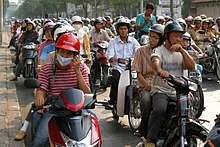
The main means of transport within the city are motorbikes, buses, taxis, and bicycles. Motorbikes remain the most common way to move around the city. Taxis are plentiful and usually have meters, although it is also common to agree on a price before taking a long trip, for example, from the airport to the city centre. For short trips, "xe ôm" (literally, "hug vehicle") motorcycle taxis are available throughout the city, usually congregating at a major intersection. A popular activity for tourists is a tour of the city on cyclos, which allow for longer trips at a more relaxed pace. For the last few years, cars have become more popular. There are approximately 340,000 cars and 3.5 million motorcycles in the city, which is almost double compared with Hanoi.[81] The growing number of cars tend to cause gridlock and contribute to air pollution. The government has called out motorcycles as the reason for the congestion and has developed plans to reduce the number of motorcycles and to improve public transport.[86]
Expressway
Ho Chi Minh City has two expressways making up the North-South Expressway system, connecting the city with other provinces. The first expressway is Ho Chi Minh City - Trung Luong Expressway, opened in 2010, connecting Ho Chi Minh City with Tiền Giang and the Mekong Delta.[87] The second one is Ho Chi Minh City - Long Thanh - Dau Giay Expressway, opened in 2015, connecting the city with Đồng Nai, Bà Rịa-Vũng Tàu and the Southeast of Vietnam.[88] The Ho Chi Minh City - Long Khanh Expressway is under planning and will be constructed in the near future.
Healthcare
The health care system of the city is relatively developed with a chain of about 100 government owned hospitals or medical centres and dozens of privately owned clinics.[41] The 1,400 bed Chợ Rẫy Hospital, upgraded by Japanese aid and the French-sponsored Institute of Cardiology and City International Hospital are among the top medical facilities in South-East Asia.
Education
High schools
Notable high schools in Ho Chi Minh City include Lê Hồng Phong High School for the Gifted, Phổ Thông Năng Khiếu High School for the Gifted, Trần Đại Nghĩa High School for the Gifted, Nguyễn Thượng Hiền High School, Nguyễn Thị Minh Khai High School, Gia Định High School, Lê Quý Đôn High School, Marie Curie High School, Võ Thị Sáu High School and among others. Though the former schools are all public, private education is also available in Ho Chi Minh City. High school consists of grade 10–12 (sophomore, junior, and senior).[89]
List of Public High schools in Ho Chi Minh City
- VNU - HCM High School for the Gifted
- Lê Hồng Phong High School for the Gifted
- Trần Đại Nghĩa High School for the Gifted
- Nguyễn Thượng Hiền High School
- Nguyễn Thị Minh Khai High School
- Bùi Thị Xuân High School
- Bình Phú High School
- Gia Định High School
- Mạc Đĩnh Chi High School
- Lê Quý Đôn High School
- Nguyễn Hữu Cầu High School
- Nguyễn Hữu Huân High School
- Marie Curie High School
- Võ Thị Sáu High School
- Chu Văn An High School
- Trưng Vương High School
- Lương Thế Vinh High School
- Trần Khai Nguyên High School
- Nguyễn Trãi High School
- Nguyễn Khuyến High School
- Nguyễn Du High School
- Nguyễn Công Trứ High School
- Nguyễn Chí Thanh High School
- Nguyen Thai Binh High School
- Thu Duc High School
List of Private High schools
- Nguyễn Khuyến High School
- Trí Đức High School
- Ngô Thời Nhiệm High School
- Khai Trí High School
- Trương Vĩnh Ký High School
Universities
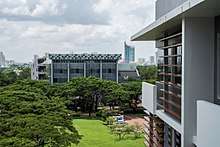

Higher education in Ho Chi Minh City is a burgeoning industry; the city boasts over 80 universities and colleges with a total of over 400,000 students.[41] Notable universities include Vietnam National University, Ho Chi Minh City, with 50,000 students distributed among six schools; The University of Technology (Vietnamese: Đại học Bách khoa, formerly Phú Thọ National Center of Technology); The University of Sciences (formerly Saigon College of Sciences); The University of Social Sciences and Humanities (formerly Saigon College of Letters); The International University; The University of Economics and Law; and the newly established University of Information Technology.
Some other important higher education establishments include HCMC University of Pedagogy, University of Economics, University of Architecture, Pham Ngoc Thach University of Medicine Nong Lam University (formerly University of Agriculture and Forestry), University of Law, University of Technical Education, University of Banking, University of Industry, Open University,[90] University of Sports and Physical Education, University of Fine Arts, University of Culture, the Conservatory of Music, the Saigon Institute of Technology, Văn Lang University, Saigon University and Hoa Sen University.
In addition to the above public universities, Ho Chi Minh City is also home to several private universities. One of the most notable is RMIT International University, Vietnam, a campus of Australian public research RMIT University with an enrollment of about 6,000 students. Tuition at RMIT is about US$40,000 for an entire course of study.[91] Other private universities include The International School of Business (Vietnam) (or ISB), an English-language university run as a partnership with universities abroad, including the University of Western Sydney and UQAM, Montreal.[92] The Saigon International University (or SIU) is another private university run by the Group of Asian International Education.[93] Enrollment at SIU averages about 12,000 students[94] Depending on the type of program, tuition at SIU costs US$5,000–6,000 per year.[95]
Culture
Museums and art galleries
Due to its history, artworks have generally been inspired by both Western and Eastern styles.
Famous art locations in Ho Chi Minh City include Ho Chi Minh City Museum of Fine Arts, and various art galleries located on Nam Ky Khoi Nghia street, Tran Phu street, and Bui Vien street.
Media

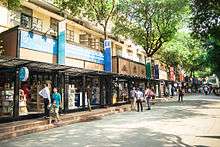
The city's media is the most developed in the country. At present, there are seven daily newspapers: Sai Gon Giai Phong (Liberated Saigon), and its Vietnamese, investment and finance, sports, evening and weekly editions; Tuổi Trẻ (Youth), the highest circulation newspaper in Vietnam; Thanh Nien (Young People), the second largest circulation in the south of Vietnam; Nguoi Lao Dong (Labourer); The Thao (Sports); Phap Luat (Law) and The Saigon Times Daily, an English-language newspaper as well as more than 30 other newspapers and magazines. The city has hundreds of printing and publishing houses, many bookstores and a widespread network of public and school libraries; the city's General Library houses over 1.5 million books. Locally based Ho Chi Minh City Television (HTV) is the second largest television network in the nation, just behind the national Vietnam Television (VTV), broadcasting 24/7 on 7 different channels (using analog and digital technology). Many major international TV channels are provided through two cable networks (SCTV and HTVC), with over one million subscribers. The Voice of Ho Chi Minh City is the largest radio station in south Vietnam.
Internet coverage, especially through ADSL connections, is rapidly expanding, with over 2,200,000 subscribers and around 5.5 million frequent users. Internet service providers (ISPs) operating in Ho Chi Minh City include the Vietnam Data Communication Company (VDC), Corporation for Finance and Promoting Technology (FPT), Netnam Company, Saigon Post and Telecommunications Services Corporation (Saigon Postel Corporation, SPT) and Viettel Company. As in all of Vietnam, Internet access is regulated; websites containing sensitive political or religious content are routinely blocked,[96] and certain websites have been blocked, though government officials deny that this is intentional. The city has more than two million fixed telephones and about fifteen million cellular phones (the latter growing annually by 20%). Mobile phone service is provided by a number of companies, including Viettel Mobile, MobiFone, VinaPhone, and Vietnam Mobile.
Sports
As of 2005, Ho Chi Minh City was home to 91 football fields, 86 swimming pools, 256 gyms.[97] The largest stadium in the city is the 25,000-seat Thống Nhất Stadium, located on Đào Duy Từ Street, in Ward 6 of District 10. The next largest is Army Stadium, located near Tan Son Nhat Airport in Tân Bình district. Army Stadium was of the venues for the 2007 AFC Asian Cup finals. As well as being a sporting venue, it is also the site of a music school. Phú Thọ Racecourse, another notable sporting venue established during colonial times, is the only racetrack in Vietnam. The city's Department of Physical Education and Sports also manages a number of clubs, including Phan Dinh Phung, Thanh Da, and Yet Kieu.
Ho Chi Minh City is home to a number of association football clubs. One of the city's largest clubs, Ho Chi Minh City F.C., is based at Thống Nhất Stadium. As Cảng Sài Gòn, they were four-time champions of Vietnam's V.League 1 (in 1986, 1993–94, 1997, and 2001–02). The team currently plays in Vietnam's First Division. Navibank Saigon F.C., founded as Quân Khu 4, also based at Thống Nhất Stadium, emerged as champions of the First Division in the 2008 season, and were promoted to the V-League in 2009. The city's police department also fielded a football team in the 1990s, Công An Thành Phố, which won the V-League championship in 1995. Celebrated striker Lê Huỳnh Đức, now manager of SHB Đà Nẵng F.C., played for the Police F.C. from 1995 to 2000, setting a league record of 25 goals in the 1996 season. Since 2016, Sài Gòn F.C. has competed in V.League 1.
In 2011, Ho Chi Minh City was awarded an expansion team for the ASEAN Basketball League.[98] SSA Saigon Heat is the first ever international professional basketball team to represent Vietnam.[99]
Ho Chi Minh City hosts a number of international sports events throughout the year, such as the AFF Futsal Championship and the Vietnam Vertical Run. Several other sports are represented by teams in the city, such as volleyball, basketball, chess, athletics, and table tennis.
International relations
Sister cities
There are 25 sister cities/regions of Ho Chi Minh City:[100]
| City | Since |
|---|---|
| Shanghai, People's Republic of China | 14 May 1994 |
| Manila, Philippines | 27 June 1994 |
| San Francisco, USA | 10 April 1995[101] |
| Osaka, Japan | 13 June 1995 |
| Guangzhou, People's Republic of China | 1 April 1996 |
| Lyon, France | 17 January 1997 |
| Shenyang, People's Republic of China | 21 April 1999 |
| Sverdlovsk Oblast, Russia | 5 September 2000 |
| Champasak Province, Laos | 28 August 2001 |
| Vientiane, Laos | 1 September 2001 |
| Rhône-Alpes (region), France | 8 November 2001 |
| Phnom Penh, Cambodia | June 2002 |
| Moscow, Russia | 31 October 2003 |
| Toronto, Ontario, Canada | 13 February 2006 |
| Yokohama, Japan | 23 July 2007 |
| Hyōgo Prefecture, Japan | 27 October 2007 |
| Minsk, Belarus | 4 November 2008[102] |
| Vladivostok, Russia | 21 May 2009 |
| Seville, Spain | 29 May 2009 |
| Johannesburg, Republic of South Africa | 10 November 2009 |
| Yangon, Myanmar | 2012 |
| Monterrey, Mexico | 27 May 2013 |
| Aichi Prefecture, Japan | 13 September 2016 |
See also
- History of Organized Crime in Saigon
- List of East Asian ports
- List of historical capitals of Vietnam
- List of tallest buildings in Vietnam
- List of historic buildings in Ho Chi Minh City
- North–South Railway (Vietnam)
- 175 Hospital
Notes
-
The text of the resolution is as follows:
"By the National Assembly of the Socialist Republic of Vietnam, 6th tenure, 1st session, for officially renaming Saigon-Gia Dinh City as Ho Chi Minh City.
The National Assembly of the Socialist Republic of Vietnam Considering the boundless love of the people of Saigon-Gia Dinh City for President Ho Chi Minh and their wish for the city to be named after him;
Considering the long and difficult revolutionary struggle launched in Saigon-Gia Dinh City, with several glorious feats, deserves the honor of being named after President Ho Chi Minh;
After discussing the suggestion of the Presidium of the National Assembly's meeting;
Decides to rename Saigon-Gia Dinh City as Ho Chi Minh City." "From Saigon to Ho Chi Minh City". People's Committee of Ho Chi Minh City. Archived from the original on 7 February 2011. Retrieved 15 June 2010. - "Un siècle plus tard (1773), la révolte des TÁYON (sic) [qu’éclata] tout, d'abord dans les montagnes de la province de Qui-Nhon, et s'étendit rapidement dans le sud, chassa de Bien-Hoa le mouvement commercial qu'y avaient attiré les Chinois. Ceux-ci abandonnèrent Cou-lao-pho, remontèrent de fleuve de Tan-Binh, et vinrent choisir la position actuele de CHOLEN. Cette création date d'environ 1778. Ils appelèrent leur nouvelle résidence TAI-NGON ou TIN-GAN. Le nom transformé par les Annamites en celui de SAIGON fut depuis appliqué à tort, par l'expédition française, au SAIGON actuel dont la dénomination locale est BEN-NGHE ou BEN-THANH." Francis Garnier, quoted in: Hồng Sến Vương, Q. Thắng Nguyễn (2002). Tuyển tập Vương Hồng Sến. Nhà xuất bản Văn học. Archived from the original on 5 May 2010. Retrieved 9 September 2017.
- "The Khmer name for Saigon, by the way, is Prey Nokor; prey means forest, nokor home or city." Norodom Sihanouk (1980). War and hope: the case for Cambodia. Pantheon Books. p. 54. ISBN 0-394-51115-8.
References
- "Area, population and population density by province". GENERAL STATISTICS OFFICE of VIETNAM. Archived from the original on 6 November 2018. Retrieved 26 September 2018.
- Metro:
Thành Phố Hồ Chí Minh; Đồng Nai; Bình Dương - "TÌNH HÌNH KINH TẾ XÃ HỘI Tháng 12 và năm 2018". Statistical Office in Ho Chi Minh City (in Vietnamese). Archived from the original on 4 January 2019. Retrieved 4 January 2019.
- "TP.HCM: GDP bình quân đầu người cuối năm 2015 đạt hơn 5.500 USD". Archived from the original on 8 December 2015.
- "Báo cáo sơ bộ Tổng điều tra Dân số và nhà ở 2019". GSO. 2019. Retrieved 20 March 2020.
- "Craft brews and skyline views the ultimate Ho Chi Minh City itinerary". National Geographic. Retrieved 23 November 2019.
- "The World According to GaWC 2018". GaWC. 13 November 2018. Archived from the original on 3 May 2017. Retrieved 24 December 2018.
- "A stock market battle bares Vietnam's North-South divisions". OZY. Retrieved 23 November 2019.
- "Building Ho Chi Minh City into a global financial centre". Vietnam Investment Review. Retrieved 23 November 2019.
- "Mastercard lists Hanoi, HCMC among top 20 Asia-Pacific travel destinations". VNExpress. Archived from the original on 22 October 2019. Retrieved 13 November 2019.
- "First foreign visitors of 2020 arrive in HCM City". Vietnam News Agency (VNA). Retrieved 4 February 2020.
- "HCMC braces for Tet gridlock around airport". VnExpress. Retrieved 4 February 2020.
- "ACV proposed as key investor for TSN airport's terminal project". The Saigon Times. Retrieved 23 November 2019.
- Vo, Nghia M. (2011). Saigon: A History. McFarland.
- Robert M. Salkin; Trudy Ring (1996). Paul E. Schellinger; Robert M. Salkin (eds.). Asia and Oceania. International Dictionary of Historic Places. 5. Taylor & Francis. pp. 353–354. ISBN 1-884964-04-4.
- Nghia M. Vo; Chat V. Dang; Hien V. Ho (29 August 2008). The Women of Vietnam. Saigon Arts, Culture & Education Institute Forum. Outskirts Press. ISBN 1-4327-2208-5. Archived from the original on 3 March 2016. Retrieved 20 December 2018.
- Chandler, David (2008). A History of Cambodia (4th ed.). Westview Press.
- Tarling, Nicholas (2000). The Cambridge history of Southeast Asia. Cambridge University Press.
- Justin Corfield (2014). Historical Dictionary of Ho Chi Minh City. Anthem Press. p. 17. Archived from the original on 28 October 2018. Retrieved 27 October 2018.
- "Comprehensive Map of Vietnam's Provinces". World Digital Library. UNESCO. 1890. Archived from the original on 30 June 2011. Retrieved 13 April 2011.
- Trương Vĩnh Ký, Souvenirs historiques sur Saigon et ses environs, trong Excursions et Reconnaissance X. Saigon, Imprimerie Coloniale 1885
- Touch Bora, 'Jacobsen history challenged', The Phnom Penh Post, 21 April 2006.
- "Historic Figures: Hồ Chí Minh (1890–1969)". British Broadcasting Corporation. Archived from the original on 22 January 2010. Retrieved 1 June 2010.
- Truong Mealy (former Cambodian Ambassador to Japan), quoted in Touch Bora, "Jacobsen history challenged", Phnom Penh Post, 21 April 2006.
- Mai Thục, Vương miện lưu đày: truyện lịch sử, Nhà xuất bản Văn hóa – thông tin, 2004, p.580; Giáo sư Hoàng Xuân Việt, Nguyễn Minh Tiến hiệu đính, Tìm hiểu lịch sử chữ quốc ngữ, Ho Chi Minh City, Công ty Văn hóa Hương Trang, pp.31–33; Helen Jarvis, Cambodia, Clio Press, 1997, p.xxiii.
- The first settlers, "Archived copy". Archived from the original on 29 September 2008. Retrieved 25 September 2008.CS1 maint: archived copy as title (link)
- "Ho Chi Minh City and around Guide – Vietnam Travel". Rough Guides. Archived from the original on 5 March 2016. Retrieved 27 February 2016.
- "Yearbook of the Encyclopedia Americana (2006)", p. 175.
- Justin Corfield (15 April 2013). Historical Dictionary of Ho Chi Minh City. Anthem Press. p. 61. ISBN 978-0-85728-235-4.
- Barrett, Tracy C. (22 February 2012). "The Chinese Diaspora in South-East Asia: The Overseas Chinese in IndoChina". I.B.Tauris – via Google Books.
- 4 April 1967 speech by Martin Luther King, Jr. at Riverside Church in New York City
- The Uncensored War: The Media and Vietnam by Daniel C. Hallin
- Woollacott, Martin (21 April 2015). "Forty years on from the fall of Saigon: witnessing the end of the Vietnam war". the Guardian. Archived from the original on 1 May 2017. Retrieved 14 December 2016.
- "Pearl of the Orient is still Vietnam's heart". Travelterrific.com. Archived from the original on 27 June 2013. Retrieved 3 April 2010.
- "Viet Nam: Ha Noi and Ho Chi Minh City Power Grid Development Sector Project" (PDF). Asian Development Bank. Archived from the original (PDF) on 23 July 2018. Retrieved 27 January 2015.
- "Vietnam Building Code Natural Physical & Climatic Data for Construction" (PDF) (in Vietnamese). Vietnam Institute for Building Science and Technology. Archived from the original (PDF) on 22 July 2018. Retrieved 23 July 2018.
- "World Weather Information Service – Ho Chi Minh City". World Meteorological Organization. Archived from the original on 27 June 2013. Retrieved 5 September 2012.
- "Flood management in Ho Chi Minh City, Vietnam". www.royalhaskoningdhv.com.
- "Saigon braces for more record tides this year - VnExpress International". VnExpress International – Latest news, business, travel and analysis from Vietnam.
- "Can coastal cities turn the tide on climate change flooding risk?". www.mckinsey.com.
- "Statistical office in Ho Chi Minh City". Pso.hochiminhcity.gov.vn. Archived from the original on 3 April 2010. Retrieved 3 April 2010.
- http://www.pso.hochiminhcity.gov.vn/c/document_library/get_file?uuid=5fdc62bc-0523-453a-b596-57ad36af9831&groupId=18
- http://www.pso.hochiminhcity.gov.vn/web/guest/niengiamthongke-nam2011
- http://www.pso.hochiminhcity.gov.vn/c/document_library/get_file?uuid=7311d5ad-c5a4-4383-8fb4-36c209afa120&groupId=18
- 01.04.1999
01.10.2004
01.04.2009
01.04.2019 - TỔNG CỤC THỐNG KÊ Archived 3 October 2018 at the Wayback Machine __gso.gov.vn
- Tổng điều tra dân số và nhà ở năm 2009 Archived 10 October 2018 at the Wayback Machine __gso.gov.vn
- GENERAL STATISTICS OFFICE of VIET NAM Archived 27 September 2018 at the Wayback Machine __gso.gov.vn
- "Report on Results of the 2019 Census". General Statistics Office of Vietnam. Retrieved 1 May 2020.
- "General Statistics Office of Vietnam". Gso.gov.vn. Archived from the original on 16 July 2011. Retrieved 4 October 2010.
- "Tong Cuc Thong Ke". Gso.gov.vn. Archived from the original on 4 April 2013. Retrieved 22 April 2013.
- Wendell Cox (22 March 2012). "THE EVOLVING URBAN FORM: HO CHI MINH CITY (SAIGON)". New Geography. New Geography. Archived from the original on 22 October 2012. Retrieved 15 October 2012.
- "Archived copy". Archived from the original on 21 March 2018. Retrieved 21 March 2018.CS1 maint: archived copy as title (link)
- Thảo Nguyên (17 August 2017). "Chủ tịch Nguyễn Thành Phong: Dự báo dân số Tp. Hồ Chí Minh đến năm 2025 là 10 triệu người nhưng nay đã đạt 13 triệu người (Chairman Nguyễn Thành Phong: The official population of Ho Chi Minh City is estimated to reach 10 million by 2025 but this number reached 13 million in 2017)". Trí thức trẻ. Archived from the original on 17 July 2018. Retrieved 17 July 2018.
- "Quy hoạch xây dựng vùng Tp.HCM". VnEconomy. 25 April 2008. Archived from the original on 10 June 2008. Retrieved 18 June 2008.
- "Cục thống kê – Tóm tắt kết quả điều tra dân số". Pso.hochiminhcity.gov.vn. 4 January 2001. Archived from the original on 23 September 2010. Retrieved 4 October 2010.
- David M. Cheney. "Thành-Phô Hô Chí Minh (Hôchiminh Ville) (Archdiocese) [Catholic-Hierarchy]". catholic-hierarchy.org. Archived from the original on 2 October 2013. Retrieved 12 August 2013.
- Statistics in 2005 Archived 13 November 2007 at the Wayback Machine on the city's official website.
- Ho Chi Minh City Economics Institute Archived 15 April 2008 at the Wayback Machine.
- Hana R. Alberts (21 December 2009). "''Forbes'' profile of Vietnam". Forbes. Archived from the original on 14 May 2012. Retrieved 24 April 2012.
- Hàn Ni, "TPHCM dẫn đầu thu hút vốn FDI vì biết cách bứt phá" Archived 15 April 2009 at the Wayback Machine. Sài Gòn giải phóng, 2007.
- "TPHCM sau 1 năm gia nhập WTO – Vượt lên chính mình..." Archived 4 April 2008 at the Wayback Machine, Trung tâm thông tin thương mại.
- Minh Anh, "Quy mô tiêu dùng 41,5 tỉ USD: Đầu kéo phát triển!" Archived 29 September 2007 at the Wayback Machine Tuổi Trẻ, 20 August 2007.
- "Ho Chi Minh City attracts record FDI in 2008". Archived from the original on 19 May 2009.
- "10 điểm nổi bật trong tình hình kinh tế – xã hội TPHCM năm 2010". Bsc.com.vn. Archived from the original on 16 January 2013. Retrieved 24 April 2012.
- VnExpress. "TP HCM đặt mục tiêu thu nhập bình quân 4.000 USD mỗi người". VnExpress. Archived from the original on 27 December 2012. Retrieved 5 January 2013.
- "Archived copy". Archived from the original on 22 October 2013. Retrieved 10 October 2013.CS1 maint: archived copy as title (link)
- "GDP bình quân đầu người của TP Hồ Chí Minh đạt 5.131 USD – Hànộimới". Hanoimoi.com.vn. Archived from the original on 5 December 2014. Retrieved 29 May 2015.
- Chỉ tiêu tổng hợp giai đoạn 2001–06 Archived 15 April 2009 at the Wayback Machine, Ho Chi Minh City government website. (Dead Link)
- Exchange rate from XE.com
- "mofahcm" (in Vietnamese). mofahcm. Archived from the original on 31 January 2010. Retrieved 3 April 2010.
Số lượng khách quốc tế đến TPHCM đã đạt tới 3 triệu lượt người, tăng 14,6% so với năm 2006, chiếm 70% tổng lượng du khách đến VN... Lượng hàng hóa vận chuyển qua cảng đạt 50,5 triệu tấn...
- "Tong Cuc Thong Ke". Gso.gov.vn. Archived from the original on 31 March 2012. Retrieved 24 April 2012.
- In 2014, tourism revenue has hit VND 78.7 trillion (US$3.7 billion), up to 4 percent compared to the same period in 2013.
- "Ho Chi Minh City backpackers' town – Tuoi Tre News". Archived from the original on 8 August 2016. Retrieved 23 June 2016.
- Archived 4 April 2008 at the Wayback Machine
- TITC. "HCM City welcomes six millionth int'l visitor in 2017". Tổng cục Du lịch Việt Nam.
- "Expansion of Saigon – Tan Son Nhat International Airport on", Sài Gòn Giải Phóng Newspaper, 13 October 2007 Archived 24 February 2009 at the Wayback Machine
- Two more Hanoi<>Saigon flights per day for Pacific Airlines on Vietnamnet.net, accessdate 11 November 2007, (in Vietnamese) Archived 22 April 2009 at the Wayback Machine
- "Airport Development News" (PDF). Archived from the original (PDF) on 8 October 2006. Retrieved 19 May 2008.
- "Train from Ho Chi Minh City – Ticket fare and Schedule | Vietnam Railways". vietnam-railway.com. Archived from the original on 31 March 2016. Retrieved 31 January 2017.
- "Print Version". .mt.gov.vn. 29 May 2008. Archived from the original on 1 April 2012. Retrieved 24 April 2012.
- "City to expand waterway transport". Vietnam News Service. 19 April 2010. Archived from the original on 21 April 2010. Retrieved 3 October 2017.
- Vietnam Insider, "First Metro Line in Ho Chi Minh to Launch Next Year", 19 February 2020
- "Ho Chi Minh City Metro". Railway-technology.com. Archived from the original on 4 May 2010. Retrieved 4 April 2010.
- Dinh Muoi. "HCMC's subway route No.2 approved". Thanh Nien. Archived from the original on 21 May 2010. Retrieved 29 April 2010.
- Hans-Heinrich Bass, Thanh Trung Nguyen (April 2013). "Imminent gridlocks". dandc.eu. Archived from the original on 5 November 2013. Retrieved 7 May 2013.
- "Dự án đường cao tốc TP.HCM – Trung Lương". Tedi.vn. Archived from the original on 6 May 2016. Retrieved 8 May 2016.
- "Ngày 8/2 thông xe toàn cao tốc TP.HCM – Long Thành – Dầu Giây". VnExpress. Archived from the original on 8 May 2016. Retrieved 8 May 2016.
- "High School Education system". Archived from the original on 28 April 2018.
- "Ho Chi Minh City Open University". Ou.edu.vn. Archived from the original on 13 August 2004. Retrieved 3 April 2010.
- "RMIT University website". Rmit.edu.vn. Archived from the original on 1 May 2012. Retrieved 24 April 2012.
- Tam, M. "Thanh Lap Vien Dao Tao Quoc Te". Bao Giao Duc. Retrieved 5 December 2014.
- "Saigon International University". siu.edu.vn. Archived from the original on 3 March 2013. Retrieved 2 March 2013.
- "SIU Group of Asian International Education". siu.edu.vn. Archived from the original on 7 March 2013. Retrieved 2 March 2013.
- "Schedule of Course Fees". siu.edu.vn. Archived from the original on 29 October 2008. Retrieved 2 March 2013.
- "OpenNet Initiative Vietnam Report: University Research Team Finds an Increase in Internet Censorship in Vietnam". Berkman Center for Internet & Society at Harvard University. 5 August 2006. Archived from the original on 5 September 2008. Retrieved 15 July 2008.
- Exercise and sports Archived 30 December 2009 at the Wayback Machine. PSO Ho Chi Minh City.
- "ASEAN Basketball League website". Aseanbasketballleague.com. 22 October 2011. Archived from the original on 27 December 2011. Retrieved 24 April 2012.
- "SSA Saigon Heat Joins the AirAsia ASEAN Basketball League". ABL News. 20 October 2011. Archived from the original on 27 December 2011.
- "CÁC ĐỊA PHƯƠNG NƯỚC NGOÀI ĐÃ THIẾT LẬP QUAN HỆ HỮU NGHỊ HỢP TÁC VỚI TPHCM". mofahcm.gov.vn. 9 October 2010. Archived from the original on 19 January 2011. Retrieved 8 January 2011.
- King, John (29 March 1995). "S.F. to Become Sister City With Ho Chi Minh City". SFGate. Archived from the original on 10 April 2018. Retrieved 9 April 2018.
- "Twin towns and Sister cities of Minsk [via WaybackMachine.com]" (in Russian). The department of protocol and international relations of Minsk City Executive Committee. Archived from the original on 2 May 2013. Retrieved 21 July 2013.
External links
- Official website (in Vietnamese and English)
- Ho Chi Minh City People's Council



.jpg)
